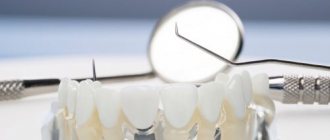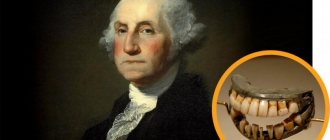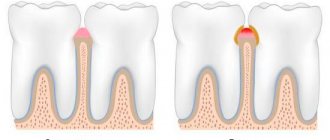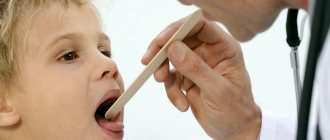October 11, 2010 - Monday
The position of a successful person today is a health fashion: playing sports, giving up bad habits, visiting cosmetologists and massage therapists... However, not everyone, not everyone, monitors the condition of their teeth. And an important role in this is played by misconceptions that have taken root in people’s minds. Indeed, in the age of developed technologies and the active implementation of innovative projects, the other side of the crazy intensification of life is the desire to get away from the hustle and bustle and the desire to believe in the miraculous and unreal.
However, if you still think that dental treatment is painful, or that a miracle paste will preserve your smile, and chewing gum will protect you from caries, congratulations, you still have not managed to separate myths and reality, and your knowledge Dentistry is full of prejudices.
How to ensure that these stereotypes, or one might say myths, do not prevent you from taking care of your smile and what really needs to be done to correct the situation, will be explained by the chief dentist of the Sverdlovsk region, Doctor of Medical Sciences, Professor, Head of the Regional Dental Clinic Marina Pavlovna Kharitonova .
Fact : The Sverdlovsk region is one of the regions with a high prevalence and average intensity of dental diseases: 14% of 6-year-old children already have permanent teeth affected by caries. Recently, diseases of periodontal tissues have also become much “younger” - more than half of adolescents aged 12-15 years have been diagnosed with tartar and increased bleeding of the gums. 96% of people over 35-40 years old have teeth affected by caries and inflammatory processes in the tissues surrounding the teeth (periodontitis). More than 70% of people over 65 years of age need orthopedic treatment, i.e. in prosthetics.
No one has ever died from a bad tooth
Reality: Infection coming from a diseased tooth (odontogenic infection) is one of the most dangerous. A diseased tooth is a source of pathogenic environment in the body. Numerous colonies of microorganisms live and multiply in the mouth, some of them quite aggressive. From a “neglected” diseased tooth, microbes can travel throughout the body, both independently and by causing allergization of the body, which leads to a decrease in immunity. In addition, ulcers on the roots with a decrease in immunity can lead to the development of serious complications (abscesses, phlegmon, osteomyelitis, etc.), and sometimes cause conditions incompatible with life.
Fact: Scientists have proven that the presence of multiple chronic foci of infection in untreated teeth in pregnant women leads to miscarriage and low fetal weight during childbirth.
What to do?
At least 1-2 times a year, undergo examination and professional hygiene at the dentist, which will help identify and effectively eliminate pathology in the initial stages of development.
Fact: Expenses of Russian residents, according to data at the beginning of the century, on certain types of goods and services (per year): - for vodka, beer, cigarettes - $12 billion, - for medicines - $2.2 billion, - for dental care – $600 million
PURULENT INFECTION OF SOFT TISSUE OF THE FACE AND NECK
Main pathogens
Purulent odontogenic infection of the soft tissues of the face and neck, tissue of deep fascial spaces is associated with the release of polymicrobial flora: F. nucleatum
, pigmented
Bacteroides, Peptostreptococcus
spp.,
Actinomyces
spp.,
Streptococcus
spp.
ABSCESSES, PHLEGMONS OF THE FACE AND NECK
Main pathogens
With an abscess in the orbital area in adults, a mixed flora is released: Peptostreptococcus
spp.,
Bacteroides
spp.,
Enterobacteriaceae
spp.,
Veillonella
spp.,
Streptococcus
spp.,
Staphylococcus
spp.,
Eikenella
Streptococcus
spp.,
Staphylococcus
. predominate in children .
The causative agents of abscesses and phlegmon of non-odontogenic origin, most often caused by minor skin lesions, are S.aureus, S.pyogenes
.
With putrefactive-necrotic phlegmon of the floor of the mouth, a polymicrobial flora is released, including F.nucleatum, Bacteroides
spp.,
Peptostreptococcus
spp.,
Streptococcus
spp.,
Actinomyces
spp.
S.aureus
can be isolated in patients with severe disease (more often in patients suffering from diabetes and alcoholism).
Choice of antimicrobials
Drugs of choice:
inhibitor-protected penicillins (amoxicillin/clavulanate, ampicillin/sulbactam), cefoperazone/sulbactam.
When P.aeruginosa
- ceftazidime + aminoglycosides.
Alternative drugs:
penicillin or oxacillin + metronidazole, lincosamides + aminoglycosides of the II-III generation, carbapenems, vancomycin.
Duration of therapy:
at least 10-14 days.
BUCCAL CELLULITE
Main pathogens
Usually observed in children under 3-5 years of age. The main pathogen is H. influenzae
type B and
S. pneumoniae
.
In children under 2 years of age, H. influenzae
is the main pathogen, and bacteremia is usually observed.
Choice of antimicrobials
Drugs of choice
: amoxicillin/clavulanate, ampicillin/sulbactam, third generation cephalosporins (cefotaxime, ceftriaxone) IV, in high doses.
Alternative drugs
: chloramphenicol, co-trimoxazole.
Duration of therapy
: depending on the severity of the current, but not less than 7-10 days.
LYMPHADENITIS OF THE FACE AND NECK
Main pathogens
Regional lymphadenitis in the face and neck is observed with infection in the oral cavity and face. Localization of lymphadenitis in the submandibular region, along the anterior and posterior surfaces of the neck in children aged 1-4 years, is usually associated with a viral infection.
Abscess formation of lymph nodes is usually caused by a bacterial infection. With unilateral lymphadenitis on the lateral surface of the neck in children over 4 years of age, GABHS and S.aureus
.
Anaerobic pathogens, such as Bacteroides
spp.,
Peptococcus
spp.,
Peptostreptococcus
spp.,
F.nucleatum, P.acnes
, can cause the development of odontogenic lymphadenitis or inflammatory diseases of the oral mucosa (gingivitis, stomatitis), cellulite.
Choice of antimicrobials
Drugs of choice: AMPs corresponding to the etiology of the primary source of infection.
If a tooth falls out, you can do just fine without it.
Reality: Each tooth in our wide smile is a link in the dental chain. Each group of teeth performs its own function: some bite off food, others chew it. When a tooth is removed or falls out, the shape of the teeth and jaws changes. The teeth adjacent to the missing one begin to shift and fill the vacated space, which can subsequently cause difficulties with prosthetics.
Fact: Significant tooth loss leads to eating more monotonous and less balanced food, a lack of vitamins and microelements, which can affect brain activity.
What to do?
Lost teeth need to be restored, which can be done in various ways. The options of choice are restorative orthopedic structures supported either by implants or by natural teeth. Fact: The fewer natural teeth a person has, the higher the risk of developing coronary heart disease and heart attack. People with fewer than 10 natural teeth are seven times more likely to die from a heart attack than those with more than 25 teeth.
Cardiovascular diseases
Pathogenic microorganisms that cause inflammation in the oral cavity can negatively affect the functioning of the heart and blood vessels. If you ignore the problem and do not carry out timely treatment, then the infection may soon migrate from the source of inflammation through the bloodstream to the heart.
Infection provokes a number of progressive pathological processes in this organ. Metabolism is disrupted, toxic waste products of microbes are formed. As a result, infectious agents infect organ tissues and create foci of secondary infection in them. As a result, the likelihood of pericarditis, endocarditis and other diseases increases.
The vessels through which the pathogen moves to the heart also become the target of damage. Their walls become inflamed, increasing the likelihood of hemorrhages, blood clots, blood pressure surges, etc.
Chewing gum, floss and toothpaste are a panacea for caries
Reality: Even the best toothpaste in the world will not cure your tooth! Chewing gum only restores the acid-base balance disturbed during meals. Floss, or, as they more often say, dental floss, is also not a doctor for our teeth. All of the above remedies are good for preventing the occurrence of carious lesions, but given the existing pathology, they are not able to not only cure, but even stop the process.
What to do?
It is necessary to use all of the above means, but only along with systematic visits to the dental office for preventive examinations, professional hygiene and sanitation of the oral cavity, i.e. treatment and maintenance in proper condition of all teeth with one or another pathology.
The more expensive the toothbrush and toothpaste, the better they are.
Reality: The cost of hygiene products is not an indicator of their usefulness specifically for you. The structure of dental tissues, their location, color, shape, as well as characters, are different for everyone.
What to do?
The selection of oral hygiene products should only be carried out by your treating dentist. In addition, the doctor will evaluate the correctness of your usual cleaning method and make the necessary adjustments.
Fact: The quality of teeth cleaning is influenced not so much by the toothbrush and toothpaste you choose, but by the correctness and duration of this manipulation. It has been proven that with a recommended time of about 3-5 minutes, most often the average person on the planet spends about 30 seconds brushing their teeth. Tip: To stay on time, turn on your favorite song and brush your teeth from the first chord to the last. On average, the duration of songs is the 3-5 minutes we need. Both fun and useful!
If you take several x-rays in a row, you can get high levels of radiation
Reality: According to one of the leading specialists in dental radiology, D.V. Rogatskin, one intraoral photograph of a tooth corresponds to approximately one microsievert.
The radiation dose when taking one three-dimensional image on a dental tomograph is approximately equal to the radiation dose from a panoramic image and is about 20-50 microsieverts. What to do?
You should not apply to a peaceful dental office the same concepts that are used at a nuclear test site. During the treatment process, you can and should take as many x-rays as your doctor needs, and if necessary, do not be afraid to do 1-2 studies per year on a dental tomograph. It is necessary to understand that your attending physician takes a picture, or a series of pictures, so that the quality of treatment is at the proper level and the tooth will serve you for many more years. And such a modern method as tomography of the maxillofacial area goes beyond the boundaries of conventional x-ray examination and often allows the doctor to see in volumetric form the pathology that cannot be determined on ordinary photographs.
Heredity is to blame for bad teeth
Reality : The role of heredity in the health of our teeth is extremely small and is manifested in the structure and properties of tooth tissue: enamel and dentin. In fact, a person even with not very good heredity has every chance of keeping his teeth healthy.
What to do?
Take proper care of your teeth throughout your life and make regular visits to your dentist.
Fact: Today, there is an opposite theory that lesions of specific teeth may indicate a predisposition to the pathology of a particular organ or an already existing disease.
Correlation of teeth affected by caries with pathology of internal organs
Healthy teeth and their effect on the entire body
Healthy and strong teeth are needed not only for chewing food and for the beauty of a smile. Teeth are directly interconnected with other organs of the human body. Therefore, even superficial caries requires immediate treatment; advanced diseases of the teeth and gums can lead to serious negative consequences.
The relationship between the masticatory organs and the entire body
There are cases in medicine where a patient complained of eczema, believing that it was a result of stress. But in the end it turned out that the reason lay in a diseased tooth, after the removal of which the eczema went away. Some people deliberately do not remove diseased or decayed teeth, believing that it is better to leave at least such a tooth than to get rid of it completely. Of course, dentists say something completely different: in the presence of even a small carious spot, bacteria gradually penetrate into the blood, which provokes the development of diseases of various organs. A diseased tooth can negatively affect the organs of hearing and vision, cause allergic reactions, as well as excessive hair loss. In addition, diseases of the oral cavity can provoke the development of rheumatism, kidney and heart disease. That is why you should not delay tooth extraction if necessary. If you experience any painful sensations in the oral cavity or if there is visible destruction of a tooth, you should immediately contact a dental clinic. The dentist, in consultation after the examination, will make a diagnosis and be able to answer all the patient’s questions. If the tooth can be saved, treatment will be carried out. If therapeutic treatment is impossible, the patient will be referred to a dental surgeon. Even if a tooth needs to be removed, there is no need to be upset about it. Modern technologies in dentistry make it possible to quickly and efficiently recreate a lost tooth.
The influence of diseased teeth on the health of the entire human body
The presence of diseased teeth can really affect the condition of the hairline: hair may begin to fall out, or bald spots may appear. Dental problems can also cause ear pain and dizziness. As for more serious consequences, these primarily include heart problems. Such a rare but very serious disease as Osler's endocarditis, in more than 50% of cases, develops due to untreated teeth in the oral cavity. Microbes enter the heart through the blood and damage its internal septum. Thus, in addition to their main functions, teeth have a significant impact on the entire human body. Continuous care and regular visits to preventive dental examinations will help you avoid the health problems listed above. Timely treatment will also help protect teeth from removal. Before you begin dental treatment, you need to find a trusted clinic that employs competent specialists who can pay close attention to your health. The specialists of our Dental Center will definitely be able to help you. You can make an appointment with us at the clinic by phone or on our website.









